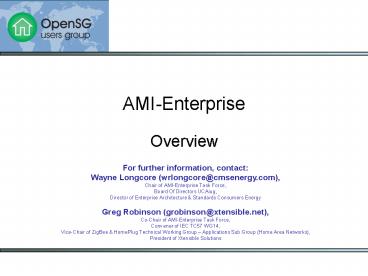Overview - PowerPoint PPT Presentation
Title:
Overview
Description:
AMI-Enterprise Overview For further information, contact: Wayne Longcore (wrlongcore_at_cmsenergy.com), Chair of AMI-Enterprise Task Force, ... Convener of IEC TC57 WG14, – PowerPoint PPT presentation
Number of Views:95
Avg rating:3.0/5.0
Title: Overview
1
AMI-Enterprise
- Overview
For further information, contact Wayne Longcore
(wrlongcore_at_cmsenergy.com), Chair of
AMI-Enterprise Task Force, Board Of Directors
UCAiug, Director of Enterprise Architecture
Standards Consumers Energy Greg Robinson
(grobinson_at_xtensible.net), Co-Chair of
AMI-Enterprise Task Force, Convener of IEC TC57
WG14, Vice-Chair of ZigBee HomePlug Technical
Working Group Applications Sub Group (Home Area
Networks), President of Xtensible Solutions
2
AMI-Enterprise Task ForceBoot Camp
- Agenda
- 100 Introductions, logistics (Randy)
- 115 Brief Overview of AMI-Ent (Greg)
- 130 System Requirements Overview (Joe)
- 215 Service Patterns IEC recommendations
(Shawn) - 245 Break
- 300 Understanding and Using UML (Joe)
- 345 Use Case Process with example (Kay)
- 430 Service Definitions Process with example
(Jerry) - 515 General discussion, questions answers
- 530 Adjourn
3
The Problem with Uncoordinated Standards
Initiatives-Each has its Own Vocabulary and
Disparate Approach
Mobile Workforce Mgmt
AM/FM/GIS
Asset Planning
Protection
SCADA
Network Planning
Risk Analysis
Work Mgmt
Market Interface
Outage Management
Maintenance Inspection
Customer Information
Demand Response
Compliance
B2C, Automated Data Exchange
HR
Financial
Network Management
4
Goal To The Maximum Reasonable Extent,Interface
Standards Should Be Based on Common Semantics
(e.g., CIM) to Avoid Adding to Integration
Anarchy
Without Common Semantics, Point-to-Point
Integration Will Continue at the Data Level
Integration anarchy is a chaos of (1) duplicated
logic, (2) duplicated data, (3) duplicated
effort, (4) newly acquired integration
difficulties, (5) lack of ability to easily
create new application functionality from
services, and (6) lack of ability to support
business processes with applications Integration
anarchy will result in higher costs and an
inflexible, brittle Smart Grid System
5
An Example of How The IEC and Utilities are
Collaborating to Define Interface Standards Based
on Common Semantics
- AMI-Ent is a user-driven organization that starts
with standards and extends them in an efficient
and quick manner to meet current utility project
requirements. - Appropriate extensions are fed back through the
CIM User Group and/or directly to the IEC. - Artifacts of this organization are from the
utility integration point-of-view, which is a
superset of the application/product-oriented
point-of-view of the generic IEC interfaces.
IEC Strategic Group on Smart Grid (SG3)
IEC TC8
Contextual Framework
Business Requirements / Use Cases
- IEC is the SDO for the Electric Industry
- SG3 is the Standard Management Board arm that
defines what IEC is doing for the SmartGrid. This
is translated into a framework. - TC8 is developing standards at the Utility needs
and requirements level and collaborates with the
other TCs that are developing technical
specifications standards. - TC57 is responsible for power system management
and associated information exchange. - WG14 (of TC57) is responsible for utility
enterprise information exchange standards using
the Common Information Model (CIM)
IEC TCs
- The UCA (Utility Communications Architecture)
User Group is dedicated to promoting the
integration and interoperability of
electric/gas/water utility. It is the User
Community for all TC57 standards and other
related users concerns. - The CIM User Group is a fast growing organization
of CIM users that provide important feedback and
suggestions to the SDO.
- OpenSG Subcommittee is responsible for (a)
rationalization of standard-setting organizations
to ensure that technical standards are developed
with independence, transparency and broad
industry representation and (b) ensuring Testing
Standards and Certification Guidelines are
defined and support functional and timing
requirements of industry initiatives and evolution
- The ZigBee HomePlug Smart Energy Alliance is
currently sponsoring an activity to update its
Smart Energy Profile to take advantage of the
standard and technology neutral CIM. - This work is planned to be proposed to become a
new part in the IEC 61968 series of standards.
6
From The OpenHAN System Requirements Specification
Smart Energy Profile 2.0 IEC TC57 WG14 Area of
Focus At The Home
7
The ZigBeeHomePlug Technical Working Group
Application Sub-Group
- Scope and Charter
- Is tasked with building an application layer
standard for a HAN which allows energy
applications to communicate with edge energy
devices over an external network (AMI, broadband
Internet, etc.) core using a common API and set
of objects. - Is concerned with services and communications
localized to a single HAN and those that enable
communications to and from the HAN. - Shall use the ZigBee Smart Energy Profile as the
forward starting point and its work shall be
mapped to IEC 61968 (CIM) and any gaps
identified.
8
(No Transcript)
9
The AMI Enterprise Task Force
- Scope and Charter
- Defines requirements, policies, and services
- Based on utility industry standards such as the
Common Information Model (CIM) - Required for information exchange and control
between the MDMS or MDUS and enterprise back
office systems.
10
AMI Enterprise Task ForceProcess Overview
http//osgug.ucaiug.org/utilityami/AMIENT































